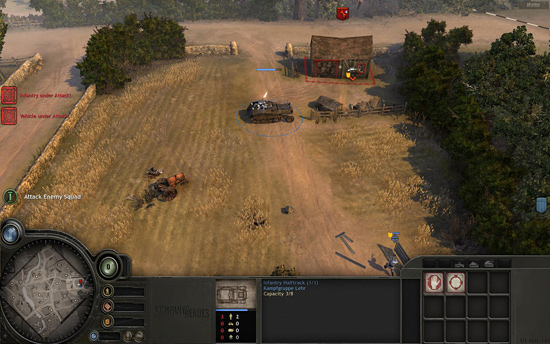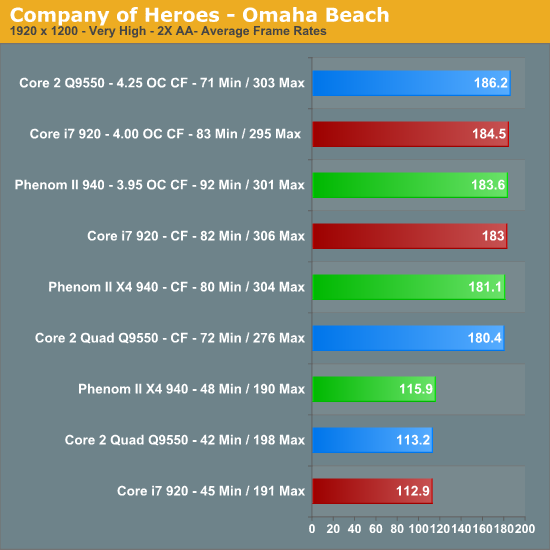CrossFireX and the Phenom II X4 940 – Competitive or Not?
by Gary Key on February 2, 2009 12:00 AM EST- Posted in
- Motherboards
Company of Heroes: Opposing Fronts

The oldest title in our test suite is still the most played. CoH has aged like fine wine and we still find it to be one of the best RTS games on the market. We look forward to the Tales of Valor standalone expansion pack this spring. In the meantime, we crank all the options up to their highest settings, enable AA at 2x, and run the game under DX9. The DX10 patch offers some improved visuals but with a premium penalty in frame rates. We track a custom replay of Able Company’s assault at Omaha Beach with FRAPS.

Just like our previous test results, we have very similar single card scores at 1680x1050. In this particular game, the Phenom II X4 940 offers the best minimum frame rates in each benchmark when compared to the Q9550 and surpasses the i7 in two tests. Only when the platform is overclocked do we see the Q9550 ahead of the Phenom II in average frame rates, a small 3% to be exact. However, the Phenom II has a 13% advantage in minimum frame rates.
Adding a second card for CrossFire operation improves average frame rates by 45% and minimum frame rates by 49% for the Phenom II. The Intel Q9550 has an improvement of 44% in the average and 81% in minimum frame rates. The Core i7 average frame rates improve by 48% and minimum rates increase 76%. Overclocking our processors resulted in a 5% average improvement in frame rates for our collective group, indicating we are largely GPU limited.
During testing, the Intel systems would generate minimum frame rates in the 23~24fps range on a couple of runs and then jump to their current results on the others. We noticed this in game play also; the Intel systems would hitch and pause at times. We would shutdown the game, clear the prefetch folder, and reboot. The game would operate fine in the next series of testing, though we still had stuttering in intensive ground scenes at times. We tried new images, different CPUs, memory changes, and the Sapphire HD 4870 cards with the same results. The Phenom II 940 had extremely stable frame rates in each test and action was very fluid during game play.

Lather, rinse, and repeat: the 1920x1200 numbers follow the same performance pattern once again - not that we expected anything different. Nevertheless, it is getting boring mentioning that same fact on every page. In single card testing the Phenom II 940 is 2% faster in average frame rates and 14% ahead in minimum frame rates compared to the Q9550. CrossFire results barely favor the Phenom II in average frame rates while minimum frame rates are about 8% better than the Q9550.
The i7 shows its strength in CrossFire testing in both average and minimum frame rates. We only experienced the previously mentioned drop in minimum frame rates a couple of times with i7 but it was still noticeable. The Q9550 finishes first again in average frame rates when overclocked but falls about 29% behind the Phenom II 940 in minimum frame rates.
Adding a second card for CrossFire operation improves average frame rates by 57% and minimum frame rates by 66% for the Phenom II. The Intel Q9550 has an improvement of 59% in the average and 71% in the minimum frame rates. The Core i7 average frame rates improve by 62% and minimum rates increase 82%. Overclocking our processors only improved frame rates 2% on average as we continue to be GPU bound at this resolution.
Now that we have discussed the numbers, what about the game play experience? As we alluded to earlier, the Intel platforms had problems with minimum frame rates throughout testing - not just in the benchmarks, but also during game play in various levels and online. We have not nailed it down yet, but we have noticed this problem consistently. In contrast, the Phenom II X4 940 had rock solid frame rates and offered the smoothest game play experience. The problem is very likely driver related in some manner (as the man who helped to start DirectX once put it, "the drivers are always broken"), but nevertheless this is an issue on the two Intel platforms.










68 Comments
View All Comments
Joe Schmoe - Tuesday, February 3, 2009 - link
This was a very good article. I'm not quite ready to build a new system just yet. But it is tax return season. I'm glad the Phenom II is competitive. We all win when AMD puts out a nice chip. I was about to jump on the I7 band wagon but decided to just grab a q6600 and save my coins for now. Hopefully this will end some of the endless flame wars going on through the forums.
Aquineas - Tuesday, February 3, 2009 - link
First of all, thanks for the hard work you put into testing. Many folks are getting hung up on 5-10 percent performance differences and making a big deal out of it . I think the most important part of the article is the part where it says, repeatedly (paraphrased):"We couldn't perceive a difference in gaming performance between platforms."
That being said, I think 18 months from now we'll see more games where the CPU differential matters more, which is right around the time I'll be doing my next system build.
myterrybear - Tuesday, February 3, 2009 - link
I agree with this as well, great job on the article & shows the point as I have ALWAYS said, when it comes down to it would ya even notice the diffrence between the 2 if you had just sat down on it & started to do stuff on it ??Yeah exactly 6 or 8 gig ram on Phenom II would be interesting, I know I've found 4 gigs on Phenom I to be very nice now that I am running a full 64bit os ( win 7 beta) on a oc to 3 ghz Phenom 9850 be. I'm just awaiting to see how things will be once I get my Phenom II 940 any second now. :)
myterrybear - Tuesday, February 3, 2009 - link
My thing that I am noticing with all these tests of core i7 vs phenom II is the fact the systems are not even ramwise. I mean what would a core i7 run like with 4 gigs of ram or if the phenom II platform had 6 gigs of ram.it's a valid argument I think.
Aquineas - Tuesday, February 3, 2009 - link
Honestly, it probably wouldn't matter much. If I were the author I'd re-run the test with 8GB on the PII, but it's probably less than a 2 percent differential.BlueBlazer - Tuesday, February 3, 2009 - link
Love to see Intel and AMD in SLI numbers!ThePooBurner - Monday, February 2, 2009 - link
Am i the only one that noticed that the results for the PhenomII were just about identical between resolutions? There should have been some form of difference unless the AMD platform is being artificially hard-capped for some reason. Otherwise that the frame rates would be identical when upping the resolution makes no sense at all. I suggest looking into it further.ThePooBurner - Monday, February 2, 2009 - link
Err, Crysis Warhead is what i meant by FarCray2.7Enigma - Tuesday, February 3, 2009 - link
This is a perfect example of why the full data is so incredibly important in teasing out the details.Yes if you look at the graphs they show a very close clustering for the single card, CF, and overclocked CF, but if you look to the right of the names you will see the min and more importantly max will scale with upgraded components. Not to the same level as one would like but there appears to be some really REALLY rough sections as the min frame rate is almost identical across the board (look at single vs. CF you see the same frame rate). That is probably due to some driver issue where both cards are not being utilized and the single card is not optimized well either.
ThePooBurner - Wednesday, February 4, 2009 - link
I think you are missing my point. When going to a higher resolution it is expect that the frame rates for a card will change. Both the min and the max as well as the average. In almost every single game tested the values for the ATi cards at all resolutions are nearly identical. This smells very fishy to me and makes me think there is some sort of artificial limit being placed on the ATi hardware.